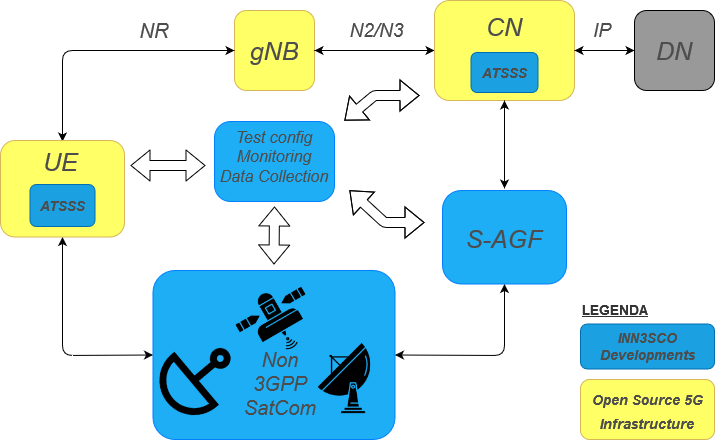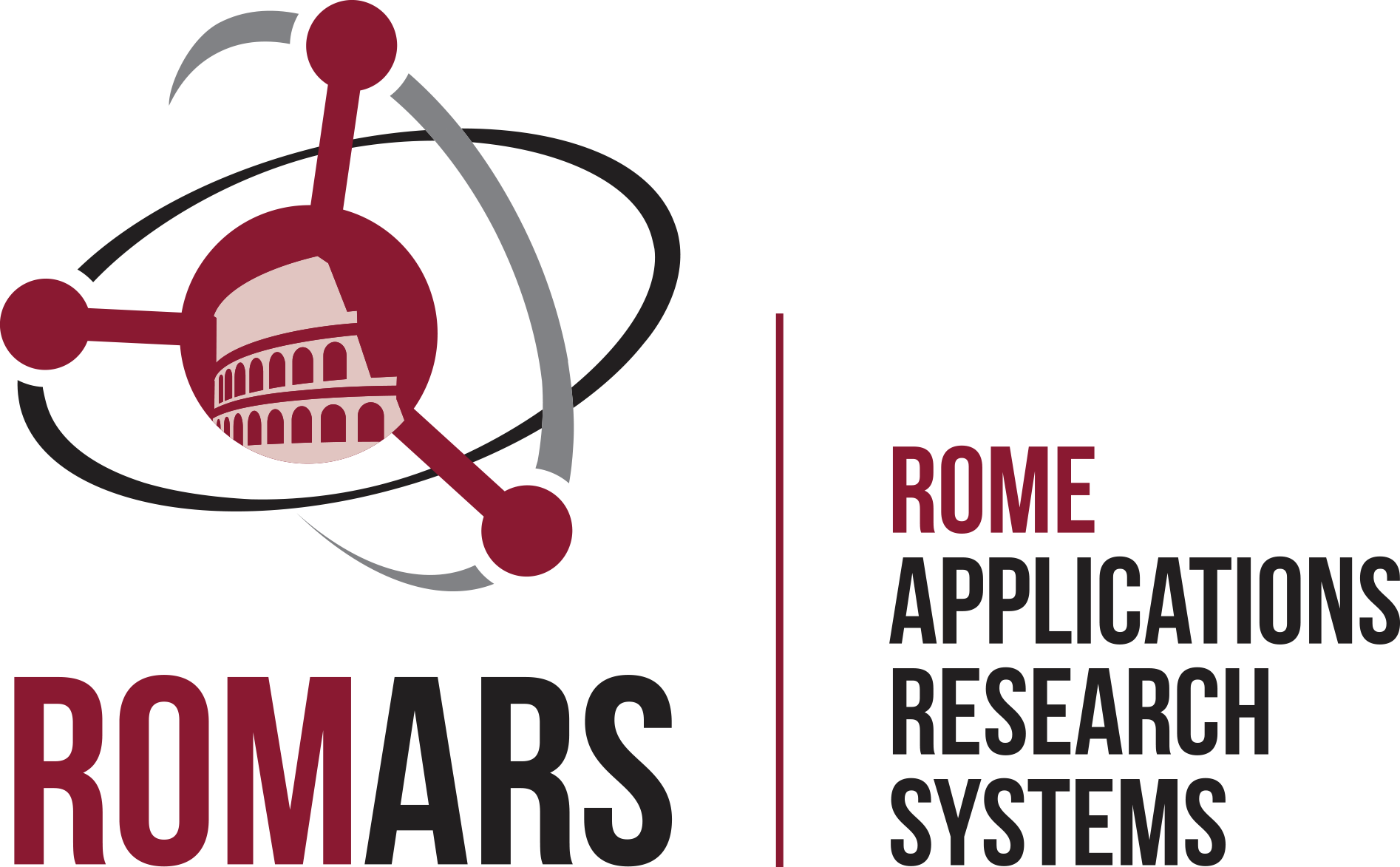
-
StatusCompleted
-
Status date2024-12-21
-
Activity Code3A.133
The main INN3SCO objective is to develop, validate and demonstrate the integration of non-3GPP satellite networks with 5G Core Networks (CN).
The current 5G specifications (release 15 and 16) allow accessing to a 5G CN via non-3GPP networks with specific Network Functions (NFs): N3IWF (Non-3GPP Inter-Working Function), TNGF (Trusted Non-3GPP Gateway Function), TWIF (Trusted WLAN Inter-Working Function) and W-AGF (Wireline Access Gateway Function). Consequently, dedicated methods for the combined use of the multi-access link (both 3GPP and non-3GPP), called Access Traffic Steering, Switching and Splitting (ATSSS) are specified. These functions currently allow 5G integration with Wi-Fi and landline broadband modems, but not with satellite.
INN3SCO goal is to extend the applicability of these functions to significant satellite-based scenarios, spanning from SATCOM/5G integrated modems for improved redundancy and resilience to IoT satellite terminals, considering as well mobile broadband connectivity to Residential Gateways for IPTV and narrowband services.
The validation and demonstration of a set of selected use-cases is carried out on a real-time testbed, where real applications can be run and evaluated. The goal is to create a solid baseline for the development plans and the commercial exploitation of non-3GPP satellite access functions.
The main challenge of INN3SCO is adapting 5G methods for non-3GPP access (designed and validated for terrestrial networks) to satellite environments. Satellite networks are constrained by peculiar and challenging physical characteristics (e.g., delay), often making use of proprietary technologies and generally tailored for specific applications and use-cases.
To address these issues, it is necessary to:
-
rework existing non-3GPP access NFs;
-
update the satellite protocol stacks control and management planes for integration;
-
enhance the ATSSS multi-access mechanisms in order to consider satellite channels characteristics.
Another significant challenge is to demonstrate these adaptations into a real-time testbed based on existing (open-source) solutions.
The access to a 5G CN through non-3GPP systems (and specifically through satellite) opens to the definition of new value-added services, which significantly enlarge the group of 5G end-user devices and use-cases possible. The specific advantages for satellite-based access include:
-
exploiting advanced in-network services as foreseen by 3GPP specifications and enabled thanks to the definition of network slices, Application Functions (AF), Multi-access/Mobile Edge Computing (MEC) and virtualization;
-
leveraging the key characteristics of satellite communication (SATCOM) technologies, such as broadcast and coverage, for ad-hoc multimedia services;
-
enabling multi-link configurations thanks to the simultaneous presence of a 3GPP access and a non-3GPP access in the same device, where the two available links can be jointly used (to perform aggregation, failover, handover, etc.).
Thanks to the alignment with 3GPP specifications, the developed solution can be integrated in any 3GPP-based 5G CN, to offer non-3GPP Satellite-based access to terrestrial Mobile Network Operators.
A customized hybrid 5G/non-3GPP-SatCom terminal or a standard 5G User Equipment (UE) enriched with non-3GPP additional interfaces towards a SATCOM platform is the main potential by-product of INN3SCO. It can allow accessing a 5G CN via a terrestrial 3GPP air interface (New Radio) and a satellite air interface (non-3GPP) either simultaneously or in alternative. This kind of multi-link access can be ruled by the optional 3GPP-defined Access Traffic Steering, Switching and Splitting (ATSSS), which is a specific project development.
These new capabilities allow a much broader applicability context to current and future 5G applications such as enabling wide/fast mobility scenarios (i.e., on-board cars, trains, airplanes or vessels, etc.), allowing redundancy and resilient configurations for mission critical and high-availability use-cases, enhanced reliability and range extension for IoT, transparent handover, failover and offloading solutions, broadcasting and IPTV satellite-assisted CDNs and terminals, etc.
In the architecture of the INN3SCO testbed, the central subsystem is the 5G CN, attached to a Data Network (DN, i.e., the Internet).
The CN is enriched with:
-
A 3GPP compliant NF, connected with the SATCOM gateway, called S-AGF
-
A dual 3GPP/non-3GPP satellite terminal UE, which can be authenticated and authorized within the CN on either of the available access links
-
Additional signalling procedures (compliant to Rel-16) to support ATSSS at the control plane of the CN
-
The data plane functions for the exploitation of ATSSS within UE and UPF (i.e., MPTCP proxy and ATSSS-LL)
The SATCOM access subsystem, in either GEO, MEO or LEO-constellation configurations, uses real technology and signalling protocols belonging to the SATCOM operator (e.g., MBI’s STARFISH). Finally, the testbed is complemented with tools for monitoring, logging and test configuration (e.g., based on the Prometheus/Grafana platform or the ELK – Elasticsearch, Logstash, Kibana – stack). UE New Radio (NR) interface and RAN/gNB are emulated and not subject to development during the project.

An interesting reference use-case is presented in the figure below, which depicts a B2B high-availability service using a dedicated 5G Satellite Residential Gateway (5G-RG) with SATCOM access (Y4 reference point).

The project duration is 24 months, and three milestones are foreseen:
-
Baseline Design Review (BDR, KO+6mo)
-
Critical Design Review (CDR, KO+15mo)
-
Final Review (FR, KO+24mo).
Technical activities are organized in 4 main Work Packages:
-
Specification of the target scenarios, the operational use-cases, the involved technologies and the testbed
-
Consolidation of the technical specification, definition of the system requirements, architecture, development and validation plans
-
Development, implementation, integration and validation of the real-time testbed
-
Real Applications performance evaluation (i.e., voice, video streaming, data download, etc.) and critical assessment of the outcomes in perspective of a commercial exploitation of the solution
The project has successfully completed the FR milestone on February 2024, with the Final Presentation held at ECSAT at the Final Presentation Days of October 2024. A possible project extension to test more configurations via a CCN is currently being assessed.





